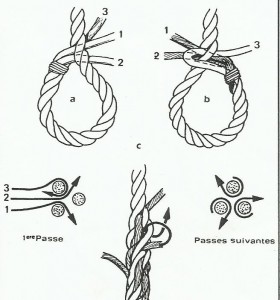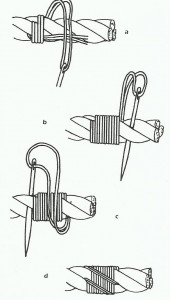Old natural fiber ropes had many drawbacks, they swelled with moisture and lost their resistance, rotted or got moldy. Their weight / strength ratio was poor, making them bulky. In addition they could injure sailor's hands especially in cold weather(example: papyrus, Coconut fiber, hemp fiber, sisal…). Fortunately things have changed!
1)First synthetic ropes
.Polyamide(nylon): it comes from the coal process. when you are burning this kind of fiber it smells like celery and you see a white smoke, it is used for mooring ropes and anchor lines because it's resilient .
.Polyester: it comes from oil, its flame creates a black smoke. Less distendable than the polyamide, it may even be non-deformable after treatment(prestretching)in manufacturing . It is therefore useful for ropes where slack on it may be bad(ex: halyards). It is widely used to make sheaths on Kevlar or spectra souls.
.Polypropylene: comes from oil too, it smells like wax being consumed. This is the weakest of the three but also the cheapest, and it has the skill to float . It can be used as moorings but it is mostly used for safety gear(ex: rope for the horseshoe buoy linked with the floating light in case of man overboard).
2)New synthetic ropes
.Polyethylene: white colored it smells like wax when it's burning. Its good ratio weight / strength allows weight's reductions on the rigging, particularly on the top(spectra, dyneema).
.Aramidic fiber(kevlar): yellow/beige colored, unable to melge. However he fears abrasion and U.V, it is necessary to use it under sheath to protect it. It is used for halyards, runners and spinnaker guy.
.LPC(vectran): it is yellow and is used to make many textile shackles and fasteners.
.PBO(zylon): yellow colored. under sheath, is used to make shrouds.
3)Words used for ropes
.Density: it is the floating ability, as the water's density = 1, if the rope has a density<1 it will float. Otherwise it will sink .
.Tenacity: snapping resistance.
.Creep(I guess in English...: this is irreversible's elongation under a steady load.
.Ingress of humidity: is the water's amount retained by the fiber after immersion(gived in %).
About the snapping load there are abacus used in rope's choice, we can also use this formula:
Tension=S*V^2*0,02104(S = sail's surface, V = wind speed in knots, Tension in kg).
For cruises the average tension has to be multiplied by 4. Use of the rope is done at 25% of its snapping load. For competition we look for a use with a higher percentage on snapping load, simply just to gain weight.
4)Ropes length
Generally we count at least length used with three turns around the winch and 1,5 m of sleeping part, then add 1.5 / 2m at the ideal length to overlap the ends that will tire in the knots after a certain time.
.The mainsheet: it is measured by the ratio used, it should not be longer than the mark used when you are running downwind(length's limit is where, as soon as we have eased off, the boom touches the leeward shrouds)plus the necessary length to manoeuver when you are sat windward.
(Notice: for a mainsail's tackle, The multiplication ratio of mainsheet is equal to the number of outgoing strands from the tackle, only tackle's part which is moving)
.Mainsail's halyard: it must be fixed on the deck when it's not used with at least a sleeping part of 2 meters after the jam cleat exit.
.The mainsheet traveller: being eased off downwind it has nevertheless to be used easily when you are hiking.
.The topping lift: it must be linked on the spi pole when this one is laying on the deck, and it must pass on the mast foot too, and allow free passage of the jib sheet.
Reefing line: they must be long enough to be set up on the mainsail when it's all hoisted, or at least for the first and the second reefing line(but all the reefing lines is better especially with a reduced crew).
.Spi guy and spi sheet: about twice the length of the boat and one meter.
.Jib sheet: with a spi pole in use it must pass in front of the topping lift, above the pole and return to cockpit.
5)Whippings and splices
A knot on a rope brings a loss about 50% of its snapping load. There is nevertheless a solution for that: splices. They are done on the hawsers ends(splices on three strands hawsers are the easiest to do)and halyard ends mainly(slightly more difficult).
splice on a three-strand hawser.
Whippings protect rope's ends from damages, heat-shrinkable sleeves may also be used instead (same thing as the heat-shrinkable sheaths used in electricity)if you are not a sewing fan. It is useful to do whippings on every rope's ends onboard. The whipping wire is a fatty wire, an efficient skill needful to have a motionless wire during our sewing work, when the whipping is done we heat it with a lighter to finish the work. Here's an example of a whipping sewn on the three strands(it is better to always do sewn whippings, they are more resistant).

